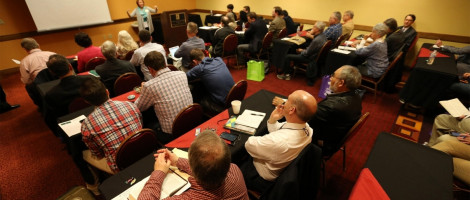Building Community Through the Observance of the Lord's Supper
by Courtney Hackett on November 10, 2015 in News

There is not a Gospel message, which cannot be shared around the table, according to presenters at "Beyond Words: Building Community Through the Observance of the Lord's Supper", an Annual Meeting workshop led by Jennifer Garcia Bashaw, assistant professor of religion, and Emily Row Prevost, director of ministry guidance and assistant professor of leadership, both at East Texas Baptist University.
Bashaw began by laying historical groundwork for the institution and practice of the Lord's Supper within the early church. Concerning the institution, Bashaw looked largely at Matthew 26:26-29 and 1 Corinthians 11 as she discussed the three ways these texts allow us to examine the Supper.
These texts provide a lens in which to look at the past, present and future. In regards to the past, the first Lord's Supper, or the Last Supper, was a time of celebrating Passover and a meal of remembrance of what God did through the Passover experience.
It is important, Bashaw noted, to take a look at the atmosphere of this meal. The disciples were lounging around the table and, while they were eating, they talked and sung and thought about the Lord and His faithfulness. In this communal meal, they truly paused to experience this act of remembrance.
Bashaw moved on to the present meal, which took place during the Last Supper and what it meant. She discussed how Jesus used this meal to explain His impending death and that the New Covenant was about to be established.
Finally, Bashaw explained that looking to the future means "looking forward to the meal together in the Kingdom someday soon."
Bashaw and Prevost went on to describe what the practice of the Supper looks like, primarily emphasizing what 1 Corinthians 11:17-18 teaches to be the proper posture of the heart when entering into the Lord's Supper. The presenters explained it was "so much more than a telling of the story", and gave an explanation of what the Supper should be for believers.
"The Supper for the early Christians is identity proclaiming," Prevost said. "It is also identity forming, in that it helps shape the Church into who the Church should be."
Prevost then posed the question of "what next?" and established five major areas of emphasis, remembrance, thanksgiving, community and hope, around the Lord's Supper. Between an explanation of each emphasis, Bashaw and Prevost opened the time up for brief small and large group discussions about the implications of such emphases in our own churches.
Prevost closed by discussing the final emphasis: hope. She explained that the Lord's Supper offers hope for the future because each time we partake, we have the opportunity to be reminded that on a coming day, we will take the Supper again in the Kingdom with the risen Jesus.
Courtney Hackett served as a guest writer during Texas Baptists' Annual Meeting, and is a junior at Dallas Baptist University.
Strengthening a multiplying movement of churches to live out the Great Commandment and Great Commission in Texas and beyond.
The ministry of Texas Baptists is made possible by giving through the Texas Baptists Cooperative Program, Mary Hill Davis Offering® for Texas Missions, Texas Baptists Worldwide and Texas Baptist Missions Foundation. Thank you for your faithful and generous support.
Subscribe to receive stories like this one directly to your inbox.
We are more together.